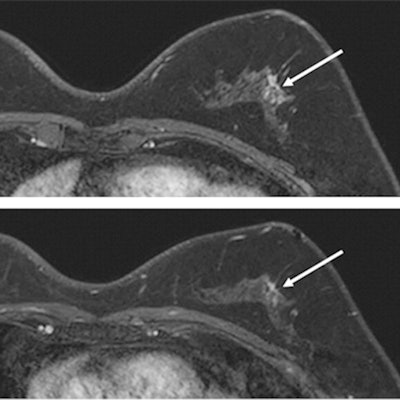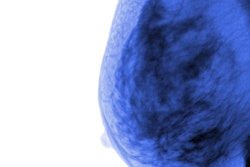
Abbreviated breast MRI has better specificity and similar sensitivity compared with full-protocol MRI in detecting breast cancer in women with a personal history of the disease, South Korean researchers found in a study published June 14 in Radiology.
Researchers led by Soo-Yeon Kim, PhD, from Seoul National University Hospital, compared the performance of abbreviated MRI and full-protocol MRI in two separate cohorts of 726 patients. They found a statistically significant improvement in specificity for the group of patients receiving abbreviated MRI. Although abbreviated MRI also yielded better sensitivity, cancer detection rate, interval cancer detection rate, and positive predictive value, those results did not reach statistical significance.
"Abbreviated MRI, with its shorter scan time, might replace full-protocol MRI when screening MRI is considered for women with a personal history of breast cancer," Kim et al wrote.
Supplemental MRI screening can help detect aggressive breast cancers that can't be fully determined on mammography. However, it is also susceptible to false-positive biopsies, high cost, and long scan times. These challenges have led to restricted recommendations for its use for women with a lifetime risk of breast cancer of at least 20%.
 Images show a 57-year-old woman who had contralateral breast tumor recurrence detected at abbreviated MRI 30 months after breast-conserving surgery. (A) Precontrast and (B) postcontrast T1-weighted MRI scans show a 1.6-cm focal heterogeneous non-mass enhancement (arrow) in the left upper outer breast. (C) Axial T2-weighted MRI scan shows no abnormal findings at the corresponding site (arrow). MRI-guided biopsy revealed low-grade DCIS. (D) Left mediolateral oblique mammogram six months before MRI shows no abnormal findings. (E) On retrospective review, there was a small non-mass enhancement (arrow) at MRI one year prior, but it was interpreted as a benign finding by a radiologist at that time. The lesion was finally proven to be invasive ductal carcinoma in the background of DCIS at the surgical histopathologic examination. Images courtesy of the RSNA.
Images show a 57-year-old woman who had contralateral breast tumor recurrence detected at abbreviated MRI 30 months after breast-conserving surgery. (A) Precontrast and (B) postcontrast T1-weighted MRI scans show a 1.6-cm focal heterogeneous non-mass enhancement (arrow) in the left upper outer breast. (C) Axial T2-weighted MRI scan shows no abnormal findings at the corresponding site (arrow). MRI-guided biopsy revealed low-grade DCIS. (D) Left mediolateral oblique mammogram six months before MRI shows no abnormal findings. (E) On retrospective review, there was a small non-mass enhancement (arrow) at MRI one year prior, but it was interpreted as a benign finding by a radiologist at that time. The lesion was finally proven to be invasive ductal carcinoma in the background of DCIS at the surgical histopathologic examination. Images courtesy of the RSNA.For women with a personal history of breast cancer, there is no consensus among researchers on the best use of MRI screening. Previous retrospective research has shown that an abbreviated MRI protocol can detect breast cancers at a higher rate compared to digital breast tomosynthesis (DBT) in women with dense breasts, as well as comparable performances to full-protocol MRI.
Kim and colleagues wanted to compare the performance of both protocols by using propensity score matching in their prospective study of 1,452 women with a personal history of breast cancer. The women had an average age of 50 years and were split equally into abbreviated and full-protocol groups. Data for the full-protocol group was collected between 2008 and 2017 while data for the abbreviated group was collected between 2017 and 2019.
| Abbreviated vs. full MRI protocols for detecting breast cancer | |||
| Full-protocol MRI | Abbreviated MRI | p-value | |
| Specificity | 86% | 93% | < 0.001 |
| Sensitivity | 69% | 100% | 0.17 |
| Cancer detection rate (per 1,000 exams) | 12 | 21 | 0.29 |
| Interval cancer rate (per 1,000 exams) | 5 | 0 | 0.13 |
| Positive predictive value | 41% | 61% | 0.16 |
In other findings, researchers also found that 93% (14 of 15) of cancers detected at abbreviated MRI were node-negative T1-invasive cancers (n = 6) or ductal carcinoma in situ (DCIS) (n = 8).
They added that the short-term follow-up rate of abbreviated MRI for BI-RADS category 3 was 5% (36 of 726 exams), compared with 12% (84 of 726 exams) for full-protocol MRI (p = 0.001). DCIS detection rate meanwhile was comparable between the two groups, with 11% for the abbreviated group and 7% for the full-protocol group (p = 0.58).
The study authors wrote that because their study was not a randomized controlled study with long-term follow-up, they could not provide evidence on breast cancer mortality or possible overdiagnosis. They called for future studies to include various screening populations to determine the generalizability of their results.
Still, the researchers concluded that abbreviated MRI protocols can be suggested as a replacement for full protocols in women with a personal history of breast cancer.



















